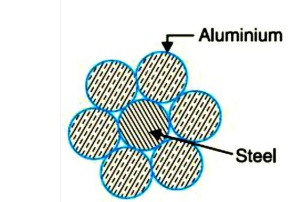Chapter: Transmission and Distribution : Transmission Line Parameters
Types of Conductor
CONDUCTORS
Commonly used conductor materials:
The most commonly used conductor materials for over head lines are copper, aluminium, steel cored aluminium, galvanised steel and cadmium copper. The choice of a particular material will depend upon the cost, the required electrical and mechanical properties and the local conditions. All conductors used for overhead lines are preferably stranded in order to increase the flexibility. In stranded conductors, there is generally one central wire and round this, successive layers of wires containing 6, 12, 18, 24 ...... wires. Thus, if there are n layers, the total number of individual wires is 3n(n + 1) + 1. In the manufacture of stranded conductors, the consecutive layers of wires are twisted or spiralled in opposite directions so that layers are bound together.
1. TYPES OF CONDUCTOR
1.Copper
Copper is an ideal material for overhead lines owing to its high electrical conductivity and greater tensile strength. It is always used in the hard drawn form as stranded conductor. Although hard drawing decreases the electrical conductivity slightly yet it increases the tensile strength considerably. Copper has high current density i.e., the current carrying capacity of copper per unit of Xsectional area is quite large. This leads to two advantages. Firstly, smaller X-sectional area of conductor is required and secondly, the area offered by the conductor to wind loads is reduced. Moreover, this metal is quite homogeneous, durable and has high scrap value. There is hardly any doubt that copper is an ideal material for transmission and distribution of electric power. However, due to its higher cost and non-availability, it is rarely used for these purposes. Now a days the trend is to use aluminium in place of copper.
2. Aluminium
Aluminium is cheap and light as compared to copper but it has much smaller conductivity and tensile strength. The relative comparison of the two materials is briefed below:
(i) The conductivity of aluminium is 60% that of copper. The smaller conductivity of aluminium means that for any particular transmission efficiency, the X-sectional area of conductor must be larger in aluminium than in copper. For the same resistance, the diameter of aluminium conductor is about 1·26 times the diameter of copper conductor. The increased X-section of aluminium exposes a greater surface to wind pressure and, therefore, supporting towers must be designed for greater transverse strength. This often requires the use of higher towers with consequence of greater sag.
(ii) The specific gravity of aluminium (2·71 gm/cc) is lower than that of copper (8·9 gm/cc).Therefore, an aluminium conductor has almost one-half the weight of equivalent copper conductor. For this reason, the supporting structures for aluminium need not be made so strong as that of copper conductor.
(iii) Aluminium conductor being light, is liable to greater swings and hence larger cross-arms are required.
(iv) Due to lower tensile strength and higher co-efficient of linear expansion of aluminium, the sag is greater in aluminium conductors. Considering the combined properties of cost, conductivity, tensile strength, weight etc., aluminium has an edge over copper. Therefore, it is being widely used as a conductor material. It is particularly profitable to use aluminium for heavy-current transmission where the conductor size is large and its cost forms a major proportion of the total cost of complete installation.
3. Steel cored aluminium
Due to low tensile strength, aluminium conductors produce greater sag. This prohibits their use for larger spans and makes them unsuitable for long distance transmission.In order to increase the tensile strength, the aluminium conductor is reinforced with a core of galvanised steel wires. The composite conductorthus obtained is known as steel cored aluminium and is abbreviated as A.C.S.R. (aluminium conductor steel reinforced).

Steel-cored aluminium conductor consists of central core of galvanized steel wires surrounded by a number of aluminium strands. Usually, diameter of both steel and aluminium wires is the same. The X-section of the two metals are generally in the ratio of 1 : 6 but can be modified to 1 : 4 in order to get more tensile strength for the conductor. Fig. shows steel cored aluminium conductor having one steel wire surrounded by six wires of aluminium. The result of this composite conductor is that steel core takes greater percentage of mechanical strength while aluminium strands carry the bulk of current. The steel cored aluminium conductors have the following
Advantages:
(i) The reinforcement with steel increases the tensile strength but at the same time keeps the composite conductor light. Therefore, steel cored aluminium conductors will produce smaller sag and hence longer spans can be used.
(ii) Due to smaller sag with steel cored aluminium conductors, towers of smaller heights can be used.
4. Galvanised steel
Steel has very high tensile strength. Therefore, galvanised steel conductors can be used for extremely long spans or for short line sections exposed to abnormally high stresses due to climatic conditions. They have been found very suitable in rural areas where cheapness is the main consideration. Due to poor conductivity and high resistance of steel, such conductors are not suitable for transmitting large power over a long distance. However, they can be used to advantage for transmitting a small power over a small distance where the size of the copper conductor desirable from economic considerations would be too small and thus unsuitable for use because of poor mechanical strength.
5. Cadmium copper
The conductor material now being employed in certain cases is copper alloyed with cadmium. An addition of 1% or 2% cadmium to copper increases the tensile strength by about 50% and the conductivity is only reduced by 15% below that of pure copper. Therefore, cadmium copper conductor can be useful for exceptionally long spans. However, due to high cost of cadmium, such conductors will be economical only for lines of small X-section i.e., where the cost of conductor material is comparatively small compared with the cost of supports.
Related Topics